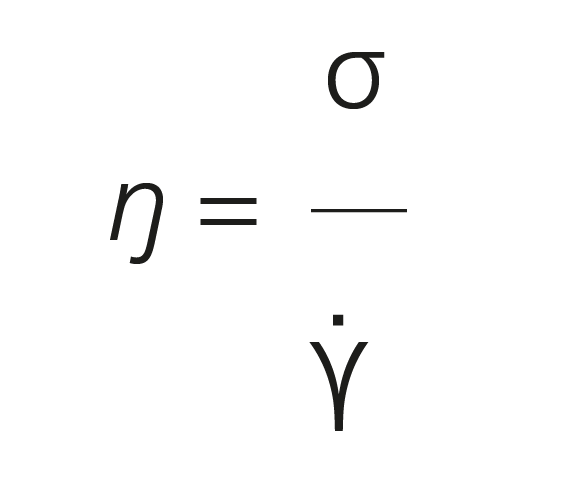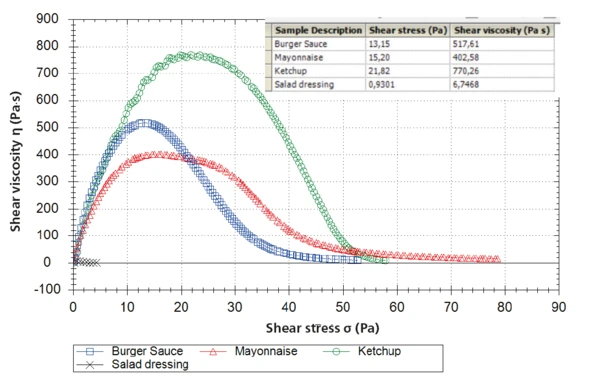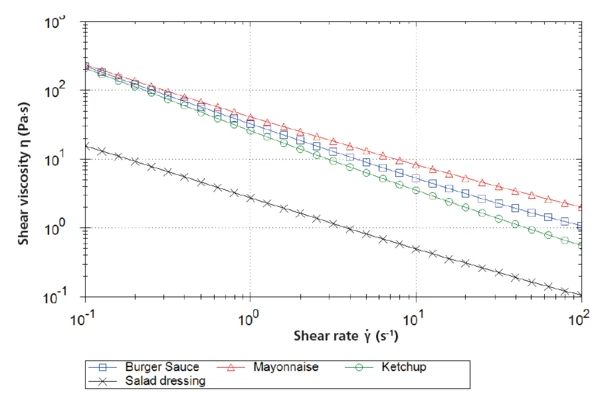Introduction
Whatever your preference: mayonnaise, ketchup, burger sauce, a good plate of burger and fries should not be without an accompanying sauce. Not only is the taste of a sauce important for the consumer, subconsciously one also expects a lot from the ‘consistency’, both in the bottle and on the plate. In order for a controlled application of sauce to your fries, it is usually squeezed from a container or hit from a glass bottle. If dipping is your desired method of consumption, then the sauce should remain in place without flowing over everything else on the plate.
Some sauces presented in bottles don´t require a force or pressure to apply, and instead, are poured. Often this is the case for a salad dressing, to be poured on the fre-quently ignored side-dish to go with the burger and fries!
How to Quantify the Pressure Required to Induce Flow; Yield Stress Analysis
The yield StressStress is defined as a level of force applied on a sample with a well-defined cross section. (Stress = force/area). Samples having a circular or rectangular cross section can be compressed or stretched. Elastic materials like rubber can be stretched up to 5 to 10 times their original length.stress represents the StressStress is defined as a level of force applied on a sample with a well-defined cross section. (Stress = force/area). Samples having a circular or rectangular cross section can be compressed or stretched. Elastic materials like rubber can be stretched up to 5 to 10 times their original length.stress that is needed to initiate a material to flow. One method of determining yield StressStress is defined as a level of force applied on a sample with a well-defined cross section. (Stress = force/area). Samples having a circular or rectangular cross section can be compressed or stretched. Elastic materials like rubber can be stretched up to 5 to 10 times their original length.stress is to apply a ‘rotational squeeze’ on the sample by gradually increasing the shear StressStress is defined as a level of force applied on a sample with a well-defined cross section. (Stress = force/area). Samples having a circular or rectangular cross section can be compressed or stretched. Elastic materials like rubber can be stretched up to 5 to 10 times their original length.stress over a specified time. Before the sample flows, the sample’s structure is stretching and resisting flow, resulting in an increase in shear viscosity as the shear StressStress is defined as a level of force applied on a sample with a well-defined cross section. (Stress = force/area). Samples having a circular or rectangular cross section can be compressed or stretched. Elastic materials like rubber can be stretched up to 5 to 10 times their original length.stress is ramped up. At the yield point, the tran-sition point between a material behaving like a solid and a fluid; the structure breaks down and the sauce starts to flow. This translates into a significant reduction in shear viscosity.
Table 1 summarizes the conditions of the yield StressStress is defined as a level of force applied on a sample with a well-defined cross section. (Stress = force/area). Samples having a circular or rectangular cross section can be compressed or stretched. Elastic materials like rubber can be stretched up to 5 to 10 times their original length.stress analysis performed on mayonnaise, ketchup, burger sauce and salad dressing.
Rotational Measurement
The upper plate rotates with a defined shear StressStress is defined as a level of force applied on a sample with a well-defined cross section. (Stress = force/area). Samples having a circular or rectangular cross section can be compressed or stretched. Elastic materials like rubber can be stretched up to 5 to 10 times their original length.stress σ [Pa]. The shear rate γ· [s-1] required for this rotation is determined. Result: The shear viscosity ŋ [Pa·s] (i.e., the resistance to the flow) is calculated

Table 1: Measurement conditions – yield StressStress is defined as a level of force applied on a sample with a well-defined cross section. (Stress = force/area). Samples having a circular or rectangular cross section can be compressed or stretched. Elastic materials like rubber can be stretched up to 5 to 10 times their original length.stress analysis
| Burger Sauce, Mayonnaise, Ketchup | Salad Dressing | |
| Geometry | Plate-plate, diameter: 40 mm, serrated | Plate-plate, diameter: 60 mm, smooth |
| Measurement gap | 3 mm | 500 μm |
| Temperature | 25°C | 25°C |
| Yield StressStress is defined as a level of force applied on a sample with a well-defined cross section. (Stress = force/area). Samples having a circular or rectangular cross section can be compressed or stretched. Elastic materials like rubber can be stretched up to 5 to 10 times their original length.stress | 0 to max. 200 Pa | 0 to max. 200 Pa |
Figure 1 depicts the results of the yield StressStress is defined as a level of force applied on a sample with a well-defined cross section. (Stress = force/area). Samples having a circular or rectangular cross section can be compressed or stretched. Elastic materials like rubber can be stretched up to 5 to 10 times their original length.stress measurements. The rSpace software automatically analyzes the yield results at the end of the measurement (Figure 1).
Ketchup requires the most stress before it starts to flow (21.8 Pa; see table in Figure 1), i.e., it is the most difficult to pump (for identical bottles). The shear viscosity achieved before flowing is the highest for this sample, nearly 800 Pa·s, compared to only 400 Pa·s for mayonnaise! This means in comparison to other sauces, it can resist the most stress before flowing. In addition, the steep decrease in viscosity of ketchup is explained by a uniform microstructure that breaks down simultaneously when the applied stresses are high enough.
The peak of the mayonnaise curve is broader and its decrease after the peak is more gradual, indicating irregularities in the structure of the emulsion. Possibly the dispersion of the oil droplets in the phase containing egg, mustard and water is not uniform.
In comparison to the other sauces, salad dressing shows a significantly smaller Yield StressYield stress is defined as the stress below which no flow occurs; literally behaves like a weak solid at rest and a liquid when yielded.yield stress (see Figure 1 bottom, curves displayed in logarithmic scaling). A shear stress of only 1 Pa·s is enough to initiate flow. However, a salad dressing made of oil and vinegar does normally not exhibit Yield StressYield stress is defined as the stress below which no flow occurs; literally behaves like a weak solid at rest and a liquid when yielded.yield stress and behaves rheologically as a Newtonian fluid: The shear viscosity is independent of shear rate. The presence of a weak but existing Yield StressYield stress is defined as the stress below which no flow occurs; literally behaves like a weak solid at rest and a liquid when yielded.yield stress in our measured dressing is due to an additional ingredient, xanthan gum. This polysaccharide is a thickening agent, providing a small Yield StressYield stress is defined as the stress below which no flow occurs; literally behaves like a weak solid at rest and a liquid when yielded.yield stress to the salad dressing.


Yield Stress and Viscosity Curve
The viscosity curve can also serve as indicator for the existence of Yield StressYield stress is defined as the stress below which no flow occurs; literally behaves like a weak solid at rest and a liquid when yielded.yield stress. An infinite increasing viscosity at low shear rates indicates that the material will not flow at rest unless there is an application of stress, enough to overcome the yield stress/point.
Table 2 and Figure 2 depict the measurement conditions and viscosity curves of all samples, respectively. All sauces are Shear ThinningThe most common type of non-Newtonian behavior is shear thinning or pseudoplastic flow, where the fluid viscosity decreases with increasing shear.shear-thinning in nature. At low shear rates, mayonnaise, ketchup and burger sauce have similar viscosity.
They differ slightly in their Shear ThinningThe most common type of non-Newtonian behavior is shear thinning or pseudoplastic flow, where the fluid viscosity decreases with increasing shear.shear-thinning behavior: The shear viscosity of ketchup (green curve) decreases faster than the other sauces with increasing shear rates. This is most probably due to a uniform structure. Furthermore, the salad dressing viscosity is approximately one decade lower than all other sauces in the complete measured range of shear rates. This property is also reflected in mouth feel of the sauces. A mayonnaise tastes creamier and has more consistency than a dressing made of oil and vinegar. A dressing that flows more readily, will coat foods or salads more evenly, whereas a more viscous, yielding sauce can be spread or used for dipping.
Table 2: Measurement conditions - viscosity curve
| Burger Sauce, Mayonnaise, Ketchup | Salad Dressing | |
| Geometry | Plate-plate, diameter: 40 mm, serrated | Plate-plate, diameter: 60 mm, smooth |
| Measurement gap | 1 mm | 500 μm |
| Temperature | 25°C | 25°C |
| Shear rates | 0.1 to 100 s-1 | 0.1 to 100 s-1 |

Conclusion
Rheological characterization of sauces is not only closely related to their flow behavior, but also in the sensation they leave in one's mouth. It provides a quantified answer to the consumer's feelings and desires: How hard should I squeeze or hit my bottle to induce flow? How creamy is my mayonnaise? Furthermore, the automatic analysis integrated in the software means easier comparisons and faster evaluations can be made.